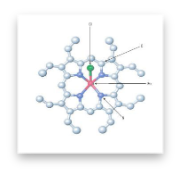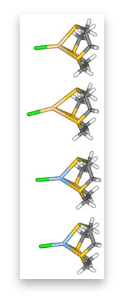Organics
Conjugated Systems
Organic conjugated systems were the theme of the Chemistry Nobel Prize of 2000. We investigate the structural, electronic and optical properties of assembled and organized polymer and molecular systems, using computational techniques ranging from totally empirical force fields (structural) to ab initio quantum mechanics (electronic). We focus mostly systems of interest to electronics and optoeletronics.
Magnetic nanostructures and biomolecules

Electric Field Gradient Study in organic molecules

The crown ethers are chemical heterocyclic compounds arranged in a ring which has several ether groups. The interest in the study of compounds containing crown ethers increased sharply after the Nobel in Chemistry [1] in 1987, by having a great facility in making coordinative bonds with other atoms and can act as a carrier of ions and small molecules.
The mechanism of action works as a lock and key model involving high binding affinities and selectivity for these entities. The size of the cavity available in each crown ether molecule varies and determines the type of cation which is bounded most efficiently. Their primary uses are the solubilization of inorganic compounds, separation of inorganic salts by use of the selectivity of various crown ethers, liquid-membrane separation, liquid-liquid extraction, ion-sensitive electrodes, and organic synthesis as phase transfer reagents.
We investigate the charge effect for isolated molecules using the recently developed projector augmented wave method PAW [2] is to evaluate EFG calculations. As an all-electron method, the PAW method lends itself naturally to EFG calculations. The PAW method has proven to be a powerful technique for studying complex systems including molecules, surfaces, and solids, and thus provides access to EFG’s in systems that can otherwise not be studied or only with difficulty.
[1] D. J. Cram, Nobel Lecture (1987).
[2]P. Blochl, Physical Review B 50, 17953 (1994).
Electronic Structure Study of Interaction between protein and carbohidrates

Frutalin is a tetrameric carbohydrate-binding protein expressed in breadfruit seeds[1]. Biomedical interest on frutalin comes from the high affinity exhibited by these molecules toward carbohydrates expressed by specific tumor cells[2]. So far, no theoretical computational studies have been carried out to investigate the binding characteristics of frutalin, which is probably due to the large number of atoms that should to be considered for in silico calculations. We investigate the binding site of frutalin with specific carbohydrate molecules using both theoretical and experimental approaches by proposing a "cut-model", considering only the carbohydrate binding site. The theoretical approach has evaluated using PAW[3], which is an ab-initio all-electron reciprocal space method based on Kohn-Sham scheme in the framework of the density functional theory(DFT)[4].
[1] P.T. Campana, Tese de Mestrado IFSC-USP (1998)
[2] V. Zucolotto, L.M. Beltramini F.C.D.A.Lima, H.M.Petrilli, Personal Communication (2009).
[3] W. Kohn, L.J. Sham, PR 140, 1133 (1965).
[4]P.E. Bloechl, Phys Rev B., 50, 17953 (1994).
[5]R. Car,M. Parrinello, Phys RevLett. 55, 2471
